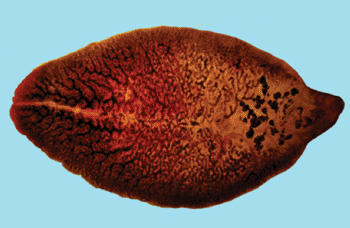Recombinant Immunoassay Diagnoses Human Fascioliasis
By LabMedica International staff writers
Posted on 03 Oct 2013
The current diagnosis of human fascioliasis involves the detection of eggs in the stool, however, eggs are not observed during the acute phase when the parasite is migrating through the tissues. Posted on 03 Oct 2013
A human immune response to Fasciola antigens occurs early in infection, therefore, an immunological method such as an enzyme-linked immunosorbent assay (ELISA) may be a more reliable, easy and cheap means to diagnose human fascioliasis than coprological analysis.

Image: Adult of Fasciola hepatica stained with carmine (Photo courtesy of US Centers for Disease Control).
Scientists from McGill University (Montreal, QC, Canada) collected serum samples from 93 Cuban individuals that were coprologically positive for eggs of F. hepatica and clinically diagnosed in the hospital. Samples were also collected from 72 Cuban and 63 Canadian individuals that were shown to be negative for Fasciola infection, and 158 serum samples obtained from individuals infected with other parasitic diseases. The ELISA test was optimized using a recombinant form of the major F. hepatica cathepsin L1 protease antigen (FhCL1).
The ELISA test using anti-total immunoglobulin G (IgG) secondary antibody gave 99.99% specificity and also exhibited 99.99% sensitivity for identifying infected individuals. The results showed that absorbance readings obtained with sera from patients infected with parasites other than F. hepatica closely matched that obtained with the negative control samples. The investigators found that using 0.55 optical density (OD) units as cut-off with anti-total IgG as secondary antibody, the test can discriminate between F. hepatica patients and all other infections examined.
The authors concluded that their standardized ELISA test using a highly stable recombinant form of cathepsin L1, FhCL1, exhibits high sensitivity and specificity and with no cross-reaction with other parasitic diseases. High production of this enzyme can be obtained by purification of Pichia pastoris culture medium, which provides sufficient quantities of material to supply diagnostic centers for mass screening in regions where human fascioliasis is prevalent. The study was published on September 19, 2013, in the journal Public Library of Science Neglected Tropical Disease.
Related Links:
McGill University














